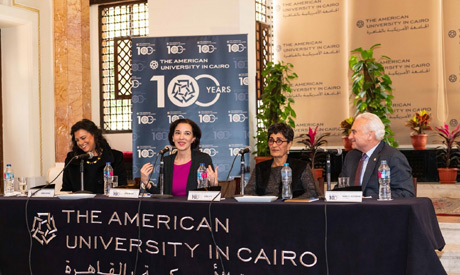
(L-r) Sherin Guirguis, Shiva Balaghi, Huda Lutfi and Francis Ricciardone (Photo courtesy of the AUC Office of Communications)
The American University in Cairo (AUC) has announced the opening of exhibitions by renowned artists Huda Lutfi and Sherin Guirguis in the lately inaugurated Tahrir Cultural Centre (TCC) at AUC's Tahrir Campus, 6 February.
###
Entitled, “When Dreams Call for Silence,” Lutfi’s exhibition is now showing in the Margo Veillon Gallery while “Bint Al-Nil/Daughter of the Nile,” by Sherin Guirguis is showing in the Future and Legacy Galleries.
The two exhibitions, curated by cultural historian, senior advisor to the president and provost of AUC for arts and cultural programmes Shiva Balaghi, mark the beginning of a series of future art exhibitions and cultural activities to take place at the TCC.
“We at AUC have always recognised Egypt, 'Mother of the Universe,' as the millennial fountainhead of creativity and the arts in this region. These dramatically fresh exhibits by internationally renowned Egyptian artists Huda Lutfi and Sherin Guirguis reaffirm this fact. We are grateful both to the veteran master and to the rising star for joining in inaugurating AUC's new Tahrir Cultural Centre, made possible by a visionary gift from prominent businessman and investor Naguib Sawiris. As we celebrate this centennial year of AUC's founding, this is a most fitting way to rededicate AUC to a second century of service to Egypt and its region,” noted AUC President Francis Ricciardone.
For her first exhibition at AUC in over 20 years, artist Lutfi has created an entirely new body of work. Comprised of drawings and paintings, sculptures and installations, the evocative artworks employ multivalent references, from surrealism to Pharaonic art, from Eastern philosophy to meditation. “There is stillness and calmness in the images,” Lutfi explains. “The mood is one of reflection and silent contemplation.”
Stemming from a period of intense artistic creativity, this exhibition takes Lutfi’s aesthetic practice into new directions. A series of evocative paintings in beautifully somber shades portray landscapes of interior spaces and deeply personal portraits. A central piece of the exhibit is a sound installation that incorporates a meditation by Rupert Spira, a teacher of philosophy and spiritual practice. Lutfi also offers an animation short with music, depicting marching figures that echo Pharaonic imagery.
“Bint Al-Nil/Daughter of the Nile” is the first ever exhibition in Egypt by Egyptian-American artist Sherin Guirguis, showing a series of paintings and sculptures inspired by Doria Shafik. “Coming across the work of Dr Doria Shafik was transformative for my artist practice. The whole of her work, as a poet, a feminist and a mother,” Guirguis explained.
On 19 February 1951, Shafik convened what had been announced as “a feminist congress” on the campus of AUC. Before the gathering of 1,500 women, Shafik declared, “Our meeting today is not a congress but a parliament. A true one! That of women! We are half the nation! We represent here the hope and despair of this important half of our nation.”
The group then marched from AUC’s Ewart Hall along Qasr Al-Aini Street to the gates of the Egyptian parliament, demanding that women be granted the right to vote and hold public office.
The protest ultimately led to a declaration by the Egyptian government in January 1956 granting women citizens the right to vote.
Over the course of two years of research as she prepared to make this body of work, Guirguis integrated ideas and concepts from Shafik’s life into her own personal history and artistic development. Hand-cut paper is a characteristic feature of Guirguis’ painting. For her, cutting is a kind of piercing, a cutting through fixed narratives, a way to create an opening. She uses materials and methods to reflect time and space.
As a whole, the artworks on display portray a search for a sense of place, a gendered reading of lost histories, and an evocative declaration of the ways the past continues to shape the present.
The two exhibitions continue through 28 February.
Short link: